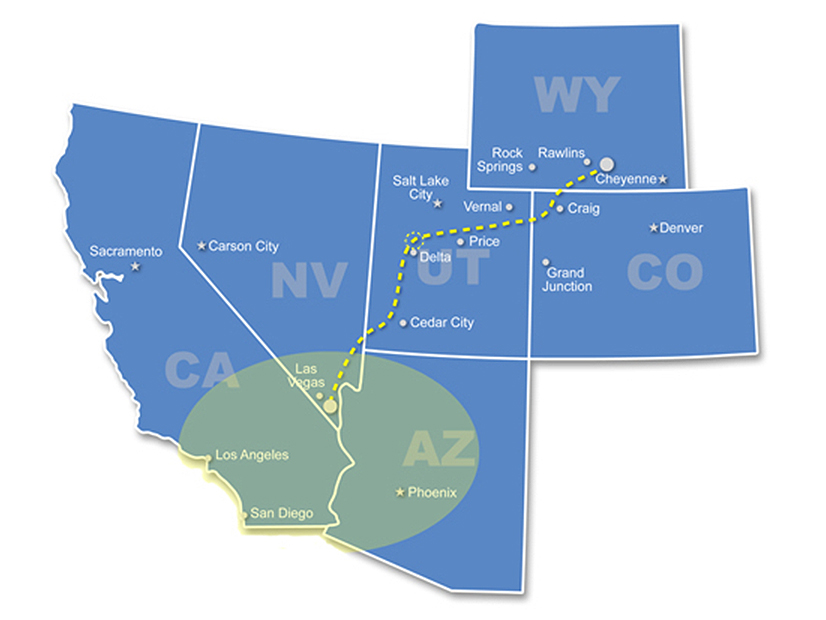
FERC on Wednesday approved an agreement that allows the developer of the TransWest Express transmission project from Wyoming to continue its bid to become a participating transmission owner in CAISO under a new “subscriber PTO” model the ISO is developing.
If FERC eventually approves the model and TransWest Express joins CAISO, it will expand the ISO’s reach as a transmission operator roughly 700 miles across the West. The TransWest project is intended to carry 3,000 MW of wind energy from Wyoming to Nevada, where it will connect with CAISO’s grid.
Wednesday’s decision dealt only with an “applicant participating transmission owner agreement” (APTOA) between CAISO and TransWest.
“The APTOA sets forth the terms and conditions that will govern TransWest’s responsibilities and relationship with CAISO until CAISO assumes operational control over TransWest’s transmission project,” FERC explained.
The agreement takes the place of CAISO’s “approved project sponsor agreement” (APSA) that it signs with developers whose transmission projects address needs identified in the ISO’s transmission planning process.
TransWest Express was not identified in the ISO’s transmission planning process and is ineligible to sign an APSA, FERC noted. The APTOA takes its place, setting out the rights and responsibilities of CAISO and TransWest during project development.
It states, for instance, that the “parties recognize and agree that CAISO is the transmission planning authority for the project transmission facilities from the time the APTOA goes into effect, regardless of the timeline for project construction or energization,” FERC said.
FERC approved the APTOA “as it largely mirrors the language already approved by the commission in the pro forma APSA. While TransWest would be ineligible to execute an APSA with CAISO … we find that the APTOA is a reasonable vehicle to address this situation.
“Like the APSA, the APTOA provides a mechanism for a potential participating TO to function as a participating TO in ways that facilitate the eventual transition … to becoming a participating TO,” it said.
“Furthermore, as CAISO explains, the APTOA bridges the gap until CAISO’s tariff and [its transmission control agreement] can govern TransWest’s relationship with CAISO as a participating TO. This will allow, among other things, any requests for generator interconnections to the project to go through and be studied in CAISO’s generator interconnection queue cluster 15, opening April 1, 2023.”
The generator interconnection to be studied is that of the line’s “subscriber,” the Power Company of Wyoming (PCW), owner of a 3,000-MW wind farm being constructed in the south-central part of the state. TransWest and PCW are affiliates, both wholly owned by the private Anschutz Corporation.
TransWest conducted a FERC-approved open-solicitation process in 2021 that offered firm, long-term transmission service to California via Utah and Nevada and decided to allocate 100% of its capacity to PCW. FERC approved the arrangement in February 2021.
Under the subscriber model, the costs of the TransWest project would not be included in CAISO’s transmission access charge, the mechanism by which costs for transmission lines are allocated to the ISO’s benefitting load-serving entities.
“Rather, TransWest intends that the transmission capacity of the project will be paid for by its transmission customer,” PCW, FERC said. “The transmission customer will in turn use its long-term transmission rights on the project to deliver wind energy and capacity to California.”
TransWest applied to join CAISO as a TO in July, saying in its application that it “intends to place under the CAISO’s operational control all of [its] project transmission lines and associated facilities.”
CAISO’s Board of Governors voted in December to admit TransWest pending further steps that include TransWest signing up energy off-takers in CAISO. (See TransWest Express to Join CAISO as Tx Owner.)
FERC must approve the subscribing participating transmission owner model once it emerges from CAISO’s stakeholder process. The ISO plans to post a draft final proposal on April 11.
“TransWest’s efforts to join CAISO as a participating TO must include certain terms and conditions that consider its agreements with PCW,” FERC noted. “In particular, the existing PCW transmission service agreements with TransWest will encumber the north-to-south capacity of the project, and that transmission capacity will be reserved for delivery of the associated wind energy and capacity to California.
“If a satisfactory subscriber PTO model cannot be developed and approved by the commission, CAISO expects that TransWest may instead move forward as an independent generation-only balancing authority,” FERC said.

